A One-Stop Kimono Destination
Preserving the Essence of Japanese Culture
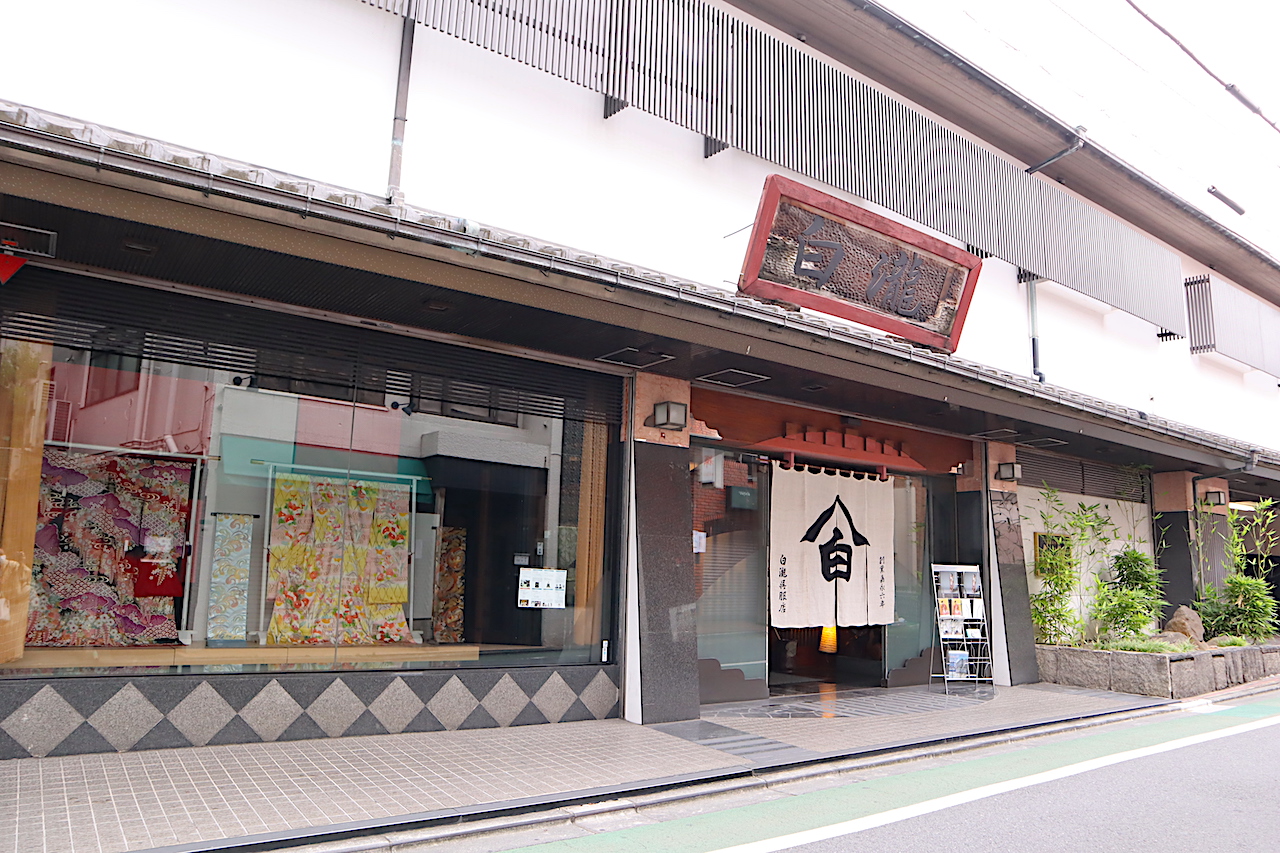
Located in Tokyo’s Nerima Ward, Shirataki Kimono Boutique(Gofukuten) has long served as a cornerstone of the local community. Once a flourishing post town, the area of Kitamachi still retains traces of its historical past. In this second feature of “The House of Heritage,” we visit Shirataki Kimono Boutique—founded in 1853 and still welcoming kimono enthusiasts from across Japan.
In This Article:
- The 170-year history of Shirataki Kimono Boutique, founded in 1853
- How Shirataki promotes kimono culture through the “Shirataki Cultural Festival”
- The philosophy behind its vast collection, known as the “Department Store of Kimono”
- The fifth-generation owner’s vision of heartfelt, lasting relationships
- The boutique’s ties with the world of shogi and its thoughtful approach to kimono fitting
A Legacy of Tradition and Elegance
Spanning Back to the Year 1853
The year 1853 marks a pivotal moment in Japanese history, when Commodore Perry of the U.S. East India Squadron arrived with his black ships, demanding the opening of Japan’s borders. That same year, Shirataki Kimono Boutique was founded. Over 170 years later, the store continues to flourish under the stewardship of Mr. Sataro Shirataki, the fifth-generation owner.This distinguished boutique exudes the dignified presence of a long-established shop. Set on a vast 10,000 square meter property—one of the largest in Tokyo—it features a garden pond, a tea room, and a remarkable selection of kimono. From formal black tomesode and colored tomesode to elegant visiting kimono and rustic tsumugi, the range reflects both refinement and diversity.
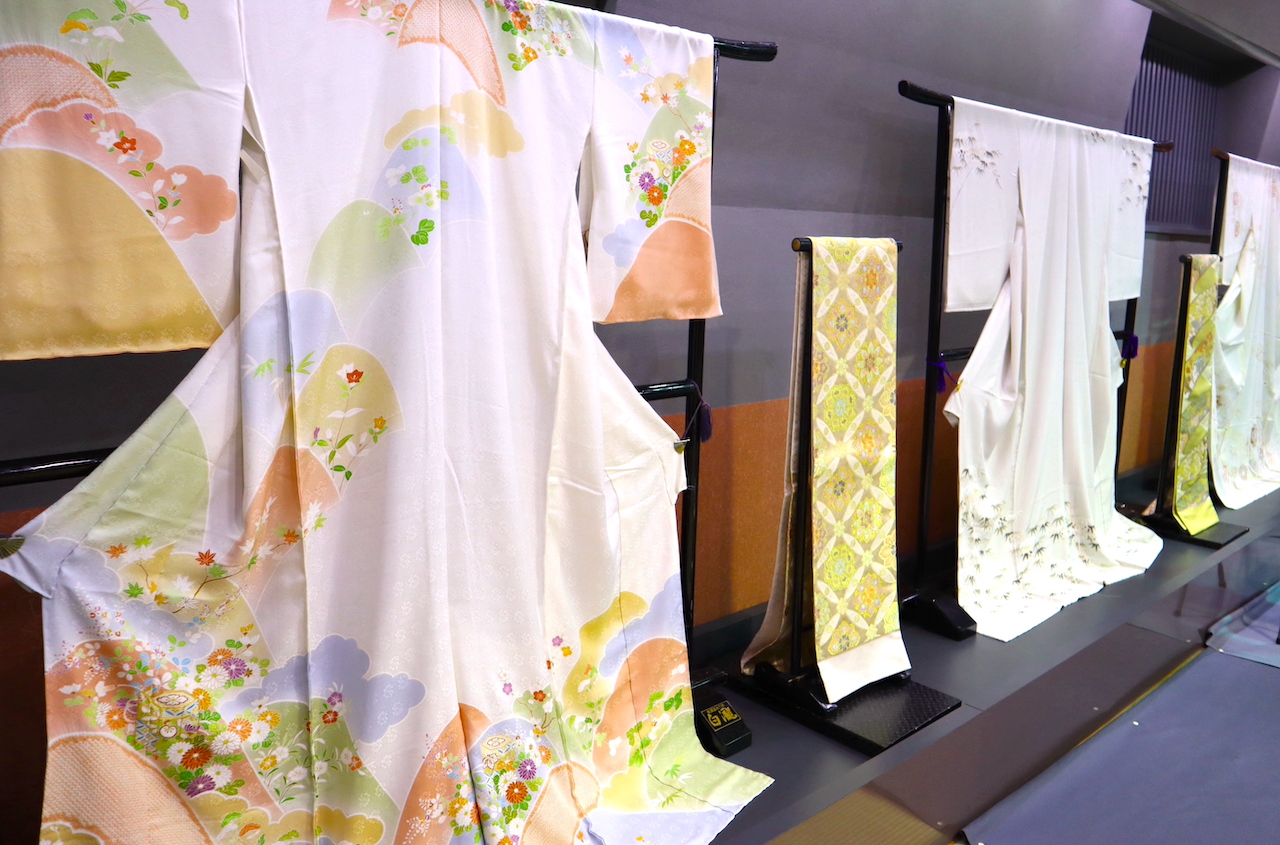
Originally founded in the Ueno area, Shirataki Kimono Boutique began as a purveyor of futon bedding and other cotton goods—merchandise commonly referred to as futomono. Later, the business relocated to Kitamachi in Tokyo’s Nerima Ward. This neighborhood once thrived as a post town along the Kawagoe Highway, which connected Kawagoe Castle to Edo Castle. Thanks to its strategic location, the shop prospered greatly during this period.
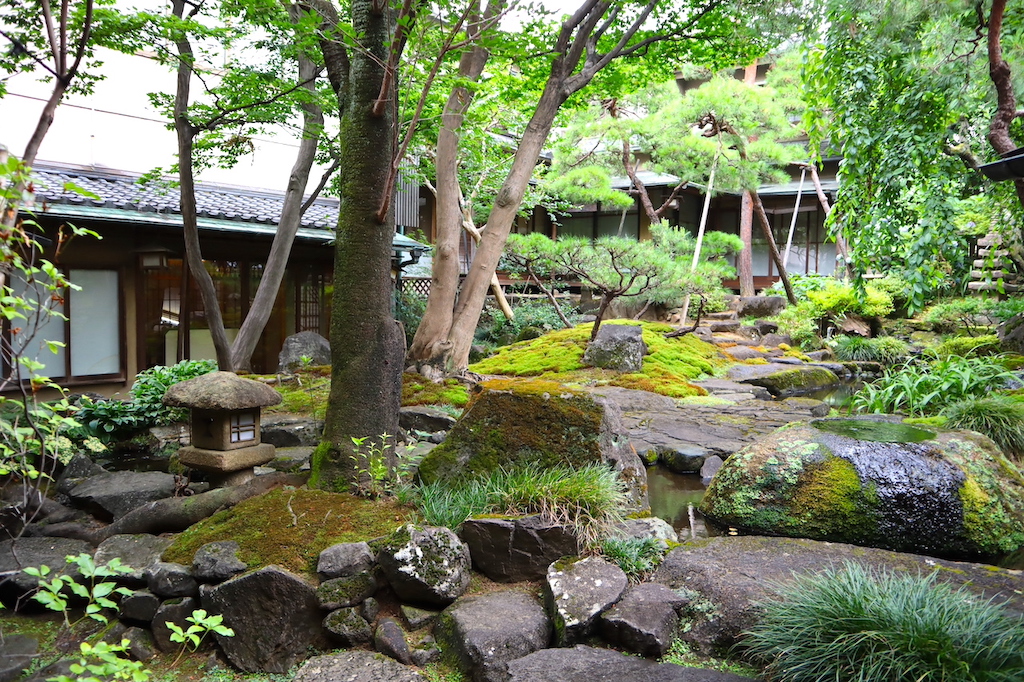
The shift toward becoming a kimono boutique specializing in silk garments began with the fourth-generation owner, the father of the current head of the shop. It is even said that Shirataki Kimono Boutique was the originator of a now-common practice in Japan—offering formal photoshoots in an in-house studio for Coming of Age Day. The idea of combining a kimono boutique with a photography studio was so innovative that other kimono retailers from across the country visited to learn from their model.
This spirit of adapting to the times has been carried on by the fifth-generation proprietor. Driven by a wish to make the boutique a “cultural hub for traditional Japanese arts,” he established the Shirataki Cultural Festival, an event featuring rakugo (comic storytelling) and Noh performances by leading artists in each field. The inspiration came from a local customer who remarked, “There are so few places where I can wear kimono these days.” In response, the boutique created an intimate venue within its own space, where guests could enjoy sake while attending performances in kimono. What began as a community gathering has grown into a full-fledged cultural event. Shirataki-san places great importance on inviting only top-tier performers—masters who are active at the forefront of their disciplines. He believes that truly moving an audience requires a depth of artistry and experience. By planning and managing the events in-house, Shirataki Kimono Boutique ensures that the quality of every element lives up to the name and legacy of the store.
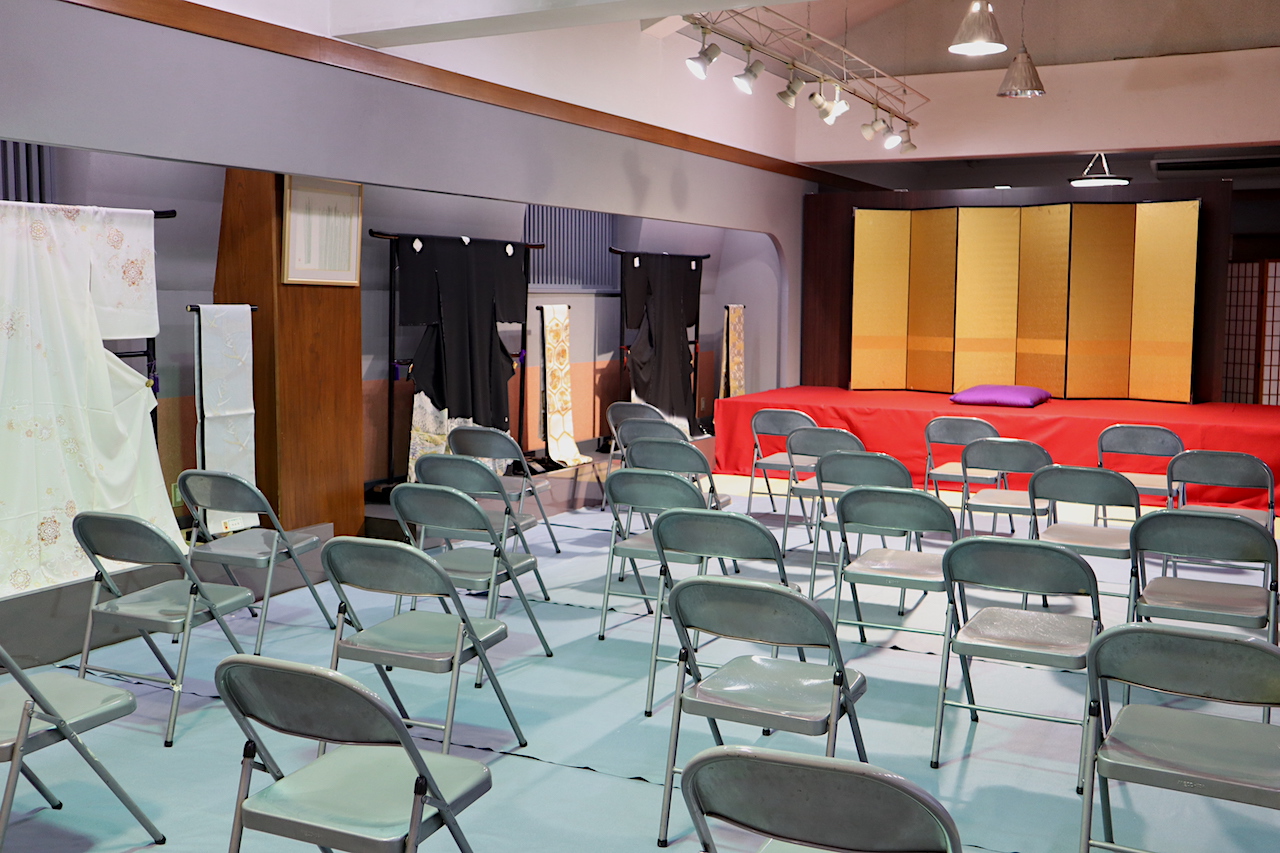
From Architecture to Kimono
And the Support That Made It Possible
Mr. Shirataki, the fifth-generation owner, has an unconventional background. After graduating from a technical college specializing in architecture, he worked as a landscape designer involved in urban planning. At the time, he had no intention of taking over the family business. However, as he witnessed the rapid transformation of Japan’s cityscapes, he began to feel a sense of urgency—that traditional Japanese culture might fade away unless consciously preserved. Realizing that he was in a unique position to carry on this heritage precisely because he was born into a kimono family, he made the decision to resign from his job at the age of 30. Reflecting on that turning point, he says: “Though I came from a completely different industry, designing landscapes and designing cultural experiences share a common thread. Whether you’re shaping something physical or intangible, the essence of design remains the same. In that sense, I saw it as a great opportunity.”
Without any formal training, he was immediately placed on the sales floor. At that time, he admits, he knew absolutely nothing about kimono—not even the difference between a kimono and a yukata. Every day was a learning experience.
“Of course, many of our customers knew far more about kimono than I did,” he recalls with a smile. “I learned so much simply by listening to them and engaging in conversation.”
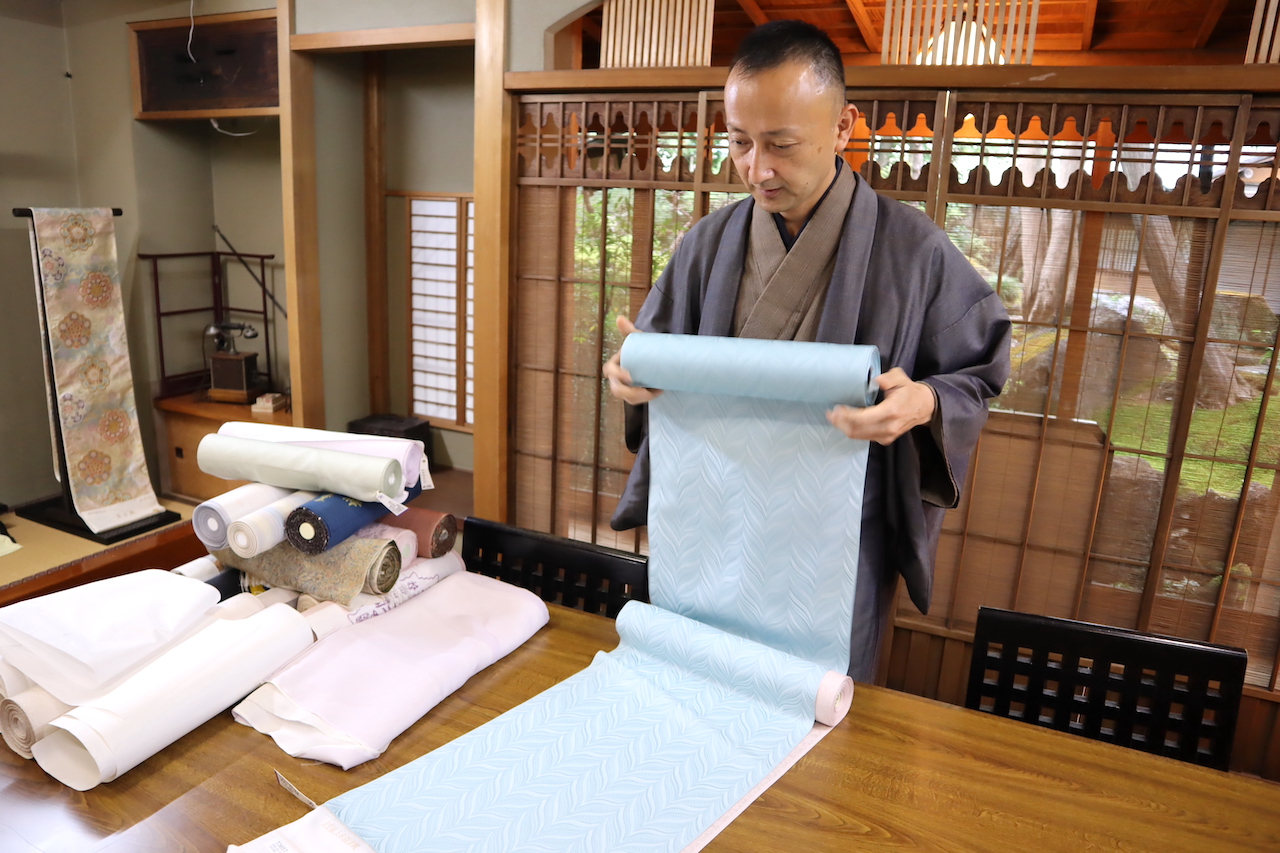
What enabled Mr. Shirataki to persevere through the challenges of entering the kimono industry was the quiet support of long-time customers who had unwavering trust in Shirataki Kimono Boutique. This realization deeply moved him. He came to believe that the shop must become a place customers can recommend with pride, and since then, he has poured his efforts into cultivating trust—focusing wholeheartedly on personalized service for each and every client.
This dedication has paid off. The boutique has inherited a solid reputation from previous generations as “the go-to place for important kimono matters.” Even today, word of mouth alone brings inquiries from across Japan, including customers who travel all the way from Kyushu to visit with their kimono in hand. Mr. Shirataki’s vision for the future is what he affectionately calls the “Disneyland Project”—a business philosophy centered around creating unforgettable experiences for customers. Just like how every part of Disneyland is designed to bring joy from the moment you enter, he hopes Shirataki Kimono Boutique can be a place where every visit leaves behind warm, lasting memories. He is constantly thinking: What should we do to make this a joyful space? What can we offer to create that experience? That spirit guides everything he does.
A Kimono Department Store
Where Every Style from Artisanal to Hybrid Finds Its Place
“At the heart of it all is our desire for customers to enjoy themselves,” says Mr. Shirataki.
That spirit is reflected in the boutique’s extraordinary inventory, which features not only pieces by renowned artisans, but also a comprehensive selection of dyeing and weaving works registered as traditional crafts from across Japan.
“We never say, ‘This is our specialty.’ That kind of statement can come across as ego-driven, and it also narrows our image,” he explains.
“Instead, our concept is to be a place where kimono lovers feel at ease. We aim to offer such a wide array of styles that visitors feel confident they’ll find the perfect piece here. That’s how committed we are to having everything covered.”
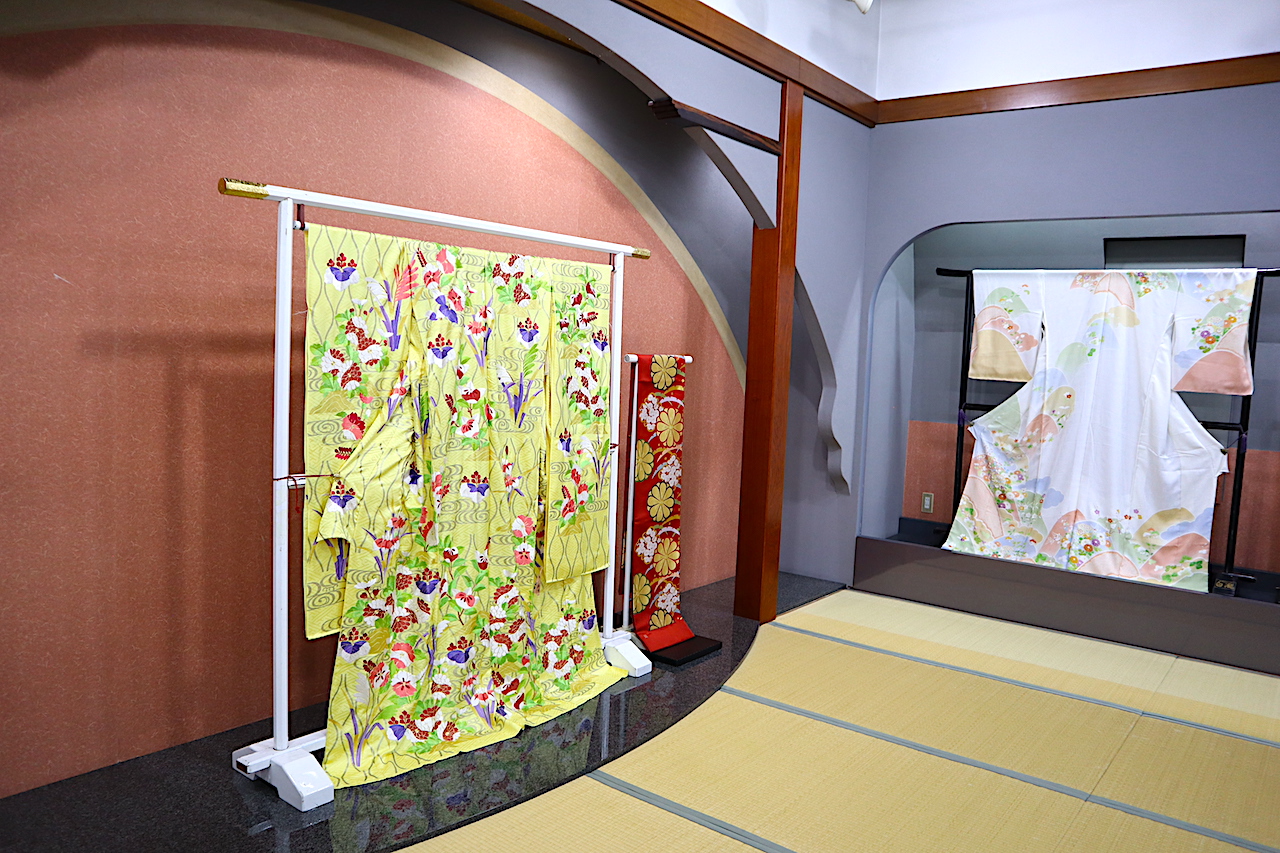
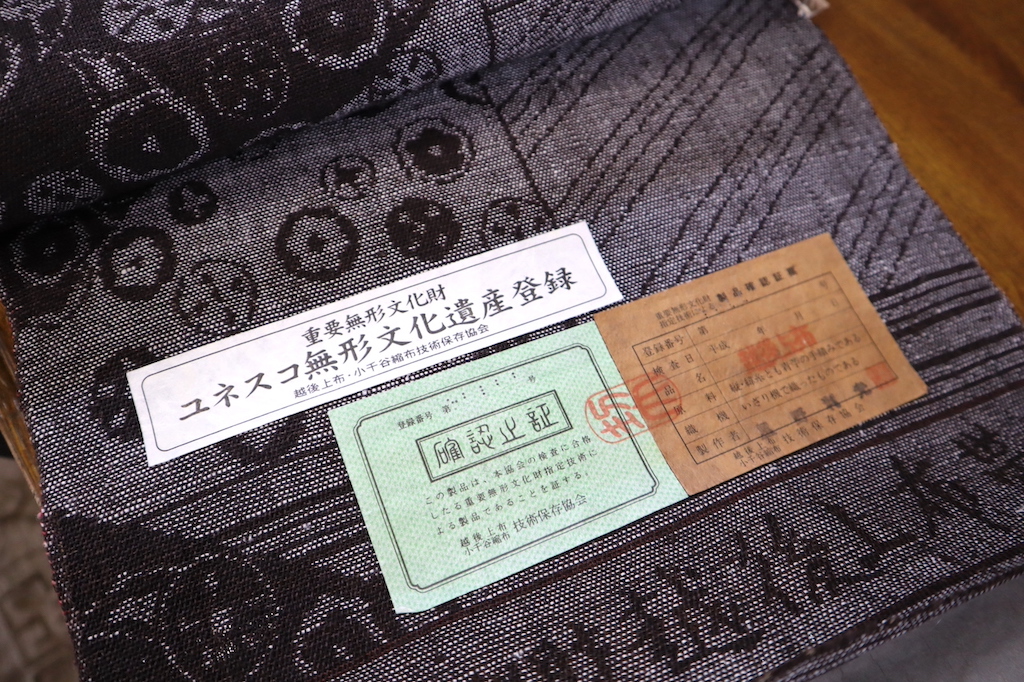
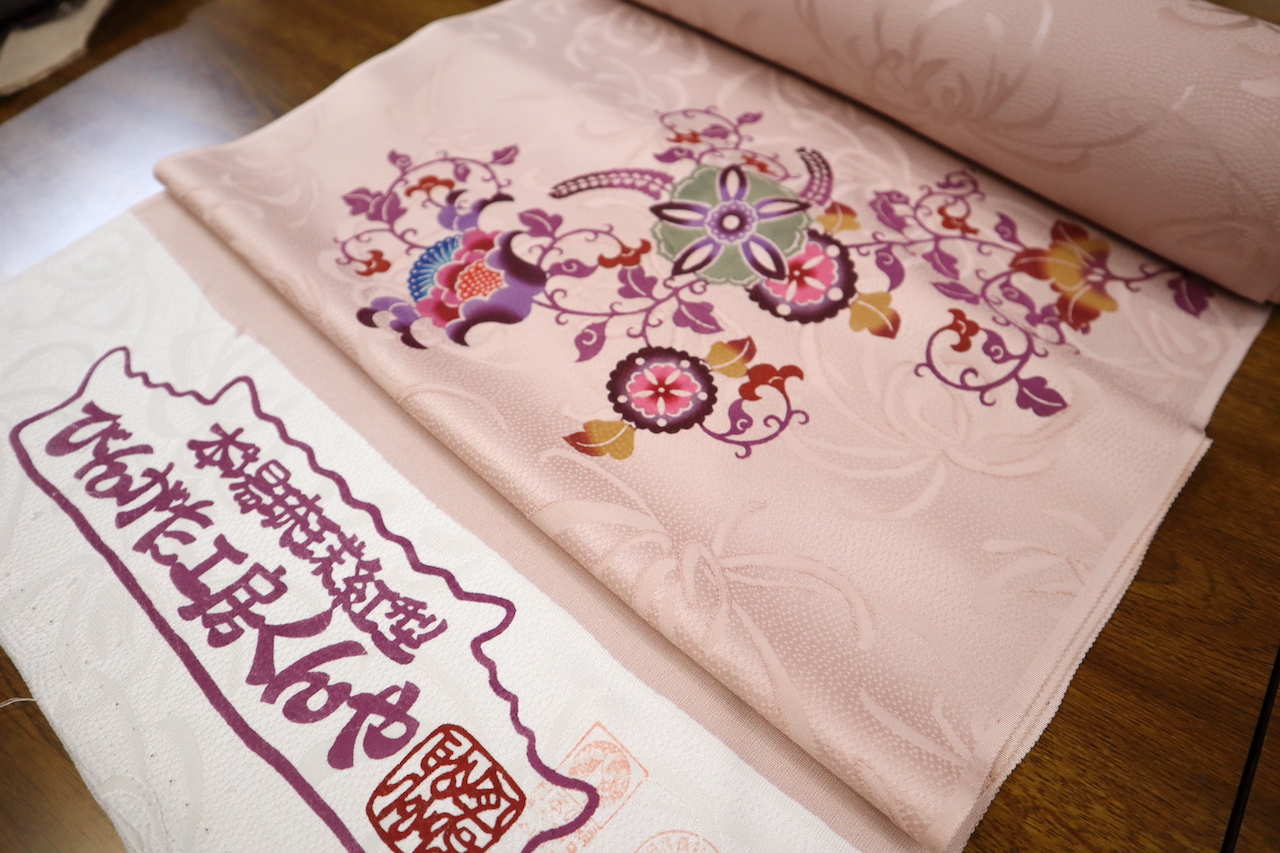
“The world is one of continual learning.”
It reflects the belief that the kimono trade is built entirely on relationships of trust — with customers, artisans, and weaving houses alike.
“We take care to price our items fairly. When we purchase from a production region, we honor the intent and wishes of the artisans. At the same time, we want to offer our customers the most reasonable price possible,” says Mr. Shirataki.
“In some cases, I’ve heard of boutiques selling at two or three times the price requested by the makers. That reality causes pain for the artisans. For us, preserving trust — both with the creators and the wearers — is essential for sustaining kimono culture. That’s why we are committed to honest, transparent business practices.”
His approach to recommending kimono is equally thoughtful.
“We don’t say, ‘This is traditional,’ or ‘This is by a famous artisan, so you should buy it.’ That’s not the point. The right kimono is the one that speaks to the customer’s heart. Whether it’s a stencil-dyed komon or a machine-made piece, each has its own appeal — whether that be the warmth of a craftsman’s hand or the accessibility of price. Our role is to understand what matters most to the customer, and to propose pieces that match their values and wishes.”
Mr. Shirataki actively encourages visitors to engage with the pieces: touch the fabrics, study the price tags, explore freely.“We hold two major sales events a year. Even when we have Important Intangible Cultural Properties on display, our message is simple: ‘Please touch and enjoy as you wish.’ The important thing is to experience the real thing and understand what fair pricing looks like. That knowledge empowers customers — even when they shop elsewhere.”
“We don’t pressure anyone,” he adds with a smile. “In fact, we mostly leave guests alone. Many tell us they find it refreshing. Of course, we’re always ready to help when asked, but our approach is to quietly observe, and step in only when our support is truly needed.”
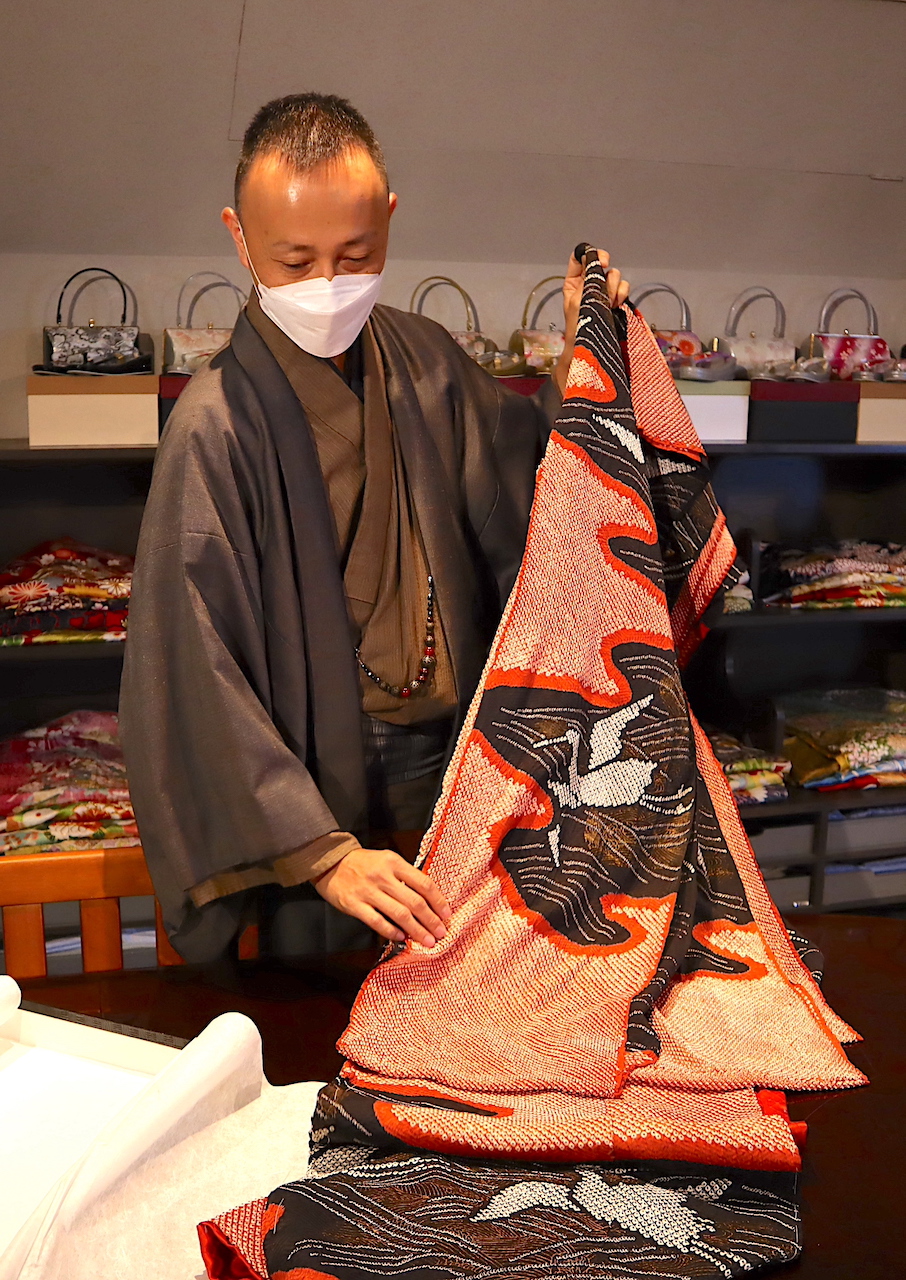
Dressing the Masters of Strategy
Shirataki Kimono Boutique and the World of Shogi
Shirataki Kimono Boutique is also known for its unique role in the world of shogi, Japanese chess — dressing professional players for their most important matches. The connection began with Mr. Shirataki’s father, a passionate shogi enthusiast who regularly visited the Shogi Hall. As word spread that he was a kimono boutique owner, the relationship naturally deepened, and Shirataki eventually came to dress the shogi professionals (kishi) themselves.
Players wear kimono when they compete for one of the eight major titles, moments of great honor and visibility. Wanting to ensure each player could perform at their best, Mr. Shirataki studied the art of kimono dressing specifically for the needs of long, mentally intense matches.
“We adjust the knot style, its position, and even reduce tightness where necessary, based on the physical tendencies of each player,” he explains. “Many of them say that kimono, especially with hakama trousers, are far more comfortable than suits for extended periods. Even when sitting cross-legged or shifting posture, the kimono remains elegant.”
With the rise of shogi stars like Souta Fujii and growing media attention around both male and female players, Mr. Shirataki hopes their dignified presence in traditional dress will inspire younger generations to take an interest in kimono culture.
Kimono Selection with True Satisfaction
A Journey of Fulfillment and Confidence
On the second floor of Shirataki Kimono Boutique, a dedicated space of over 70 tatami mats is reserved exclusively for Furisode — long-sleeved kimono traditionally worn for Coming-of-Age Day. Every year, this space becomes the starting point for the dreams of nearly 200 young women, showcasing an extensive collection that ranges from designer pieces and works by individual artisans to rare, certified traditional crafts from across Japan.
“Many customers return after their Coming-of-Age celebration to select kimono for weddings or other formal occasions. Then, after starting families, they return again for their children’s shichi-go-san ceremonies. Eventually, it’s their own daughters who come to choose a Furisode. We are truly honored to be part of these generational milestones.”
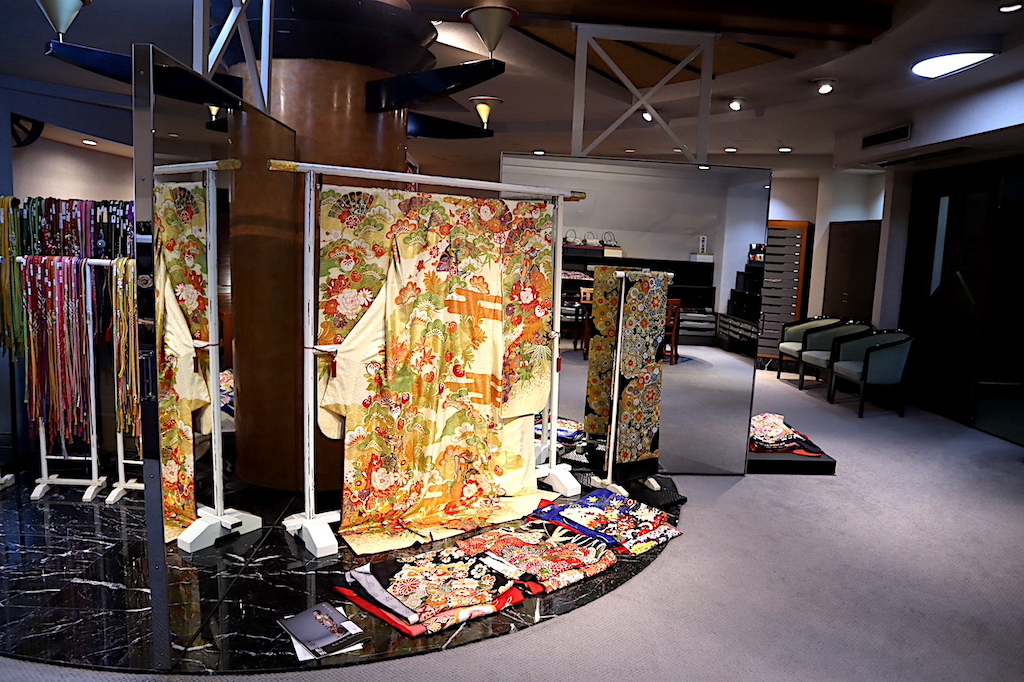
Mr. Shirataki strives to offer a level of service that delights not only daughters but also mothers and grandmothers — often hearing remarks like, “We never had anything like this in our day.” At the heart of the furisode experience is one guiding principle: let the customer try on as many kimono as they wish. On average, each young woman is invited to try on 20 to 30 different styles.
“If we narrow down the options based solely on a customer’s preferences, it limits the joy of discovery,” he explains. “What truly matters is the sense of fulfillment and confidence that comes from saying, ‘I chose this myself.’ For someone not accustomed to wearing kimono, even the first piece can feel exciting — but our role is to go beyond that, to propose something they never imagined, something that suits them perfectly.”
This approach applies not only to Furisode but to Homongi(semi-formal kimono for celebrations/formal occasions) and Komon(casual kimono with repeated small patterns) as well. Finding the right kimono brings true satisfaction — and with it, the confidence to wear it with pride. At the heart of Shirataki Kimono Boutique’s philosophy is the “Disneyland Experience Project.” This vision is about elevating both product selection and customer service to create joyful, lasting memories. Mr. Shirataki continues to evolve the boutique with one unwavering goal: to be a place people look forward to visiting again.
See Also : Shop Guide | Shirataki Kimono Boutique
__________________________________
Shirataki Kimono Boutique
8-37-11 Kitamachi, Nerima-ku, Tokyo
+81-3-3931-5601
Official Website>>
__________________________________



















